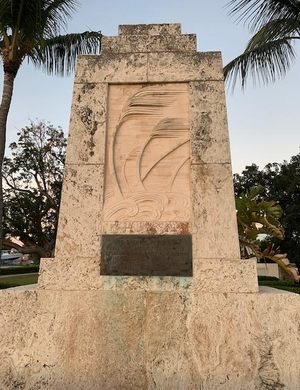Florida Keys Memorial
Dedicated to the victims of one of the deadliest hurricanes to strike the United States in recorded history.
During the night of Labor Day, September 2, 1935, the hurricane made landfall and crossed the Florida Keys before curving northward up the west coast of Florida, leaving a 40-mile wide path of destruction in its wake. It was the strongest storm in United States history at the time of landfall, and set a national record for the lowest barometric sea-level pressure. Because of forecasting errors by the U.S. Weather Bureau, there was insufficient time for evacuation; many people did not leave the Keys, resulting in hundreds of deaths. This large stone monument was built to honor the lives lost in the storm.
The storm surge from this powerful hurricane completely inundated the islands, and winds that gusted to 200 miles per hour leveled all trees and human-made structures. The tracks of the Florida East Coast Railroad were shifted off their roadbed and destroyed. The mortality rate from the hurricane is estimated at 485 deaths, of which 165 remains were never recovered. More than half of those fatalities were World War I veterans working on a Federal highway construction project. After riding out the storm in Key West, Ernest Hemingway visited the devastation by boat in hopes of rescuing survivors, but he found none.
The Florida Keys Memorial was dedicated on November 14, 1937, in a ceremony that remembered the veterans and civilians who perished in the hurricane. The simple and striking monument is carved from blocks of native Keys limestone (keystone). An 18-foot obelisk stands above a dais, which is carved with a tidal wave and palms bending in the wind. A crypt made into the upper level contains the remains of more than 300 people who perished in the storm. Many of the victims’ ashes were recovered from makeshift funeral pyres after the storm. A 22-foot-long green glazed ceramic tile map of the Florida Keys, made by ceramicist Adela Gisbet, is inlaid into the cover of the crypt.
Below the sculpture is a bronze plaque that reads: “Dedicated To The Memory Of The Civilians And The War Veterans Whose Lives Were Lost In The Hurricane Of September 2, 1935.” The monument is sometimes referred to as the “Wrong Way Hurricane Monument,” because the carved palm trees bend towards the east, and some argue they should bend west, away from the Atlantic Ocean.
























Follow us on Twitter to get the latest on the world's hidden wonders.
Like us on Facebook to get the latest on the world's hidden wonders.
Follow us on Twitter Like us on Facebook